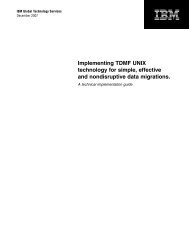A Primer for Healthcare Managers - IBM
A Primer for Healthcare Managers - IBM
A Primer for Healthcare Managers - IBM
Create successful ePaper yourself
Turn your PDF publications into a flip-book with our unique Google optimized e-Paper software.
14<br />
Analyzing sourcing needs<br />
Sourcing needs go beyond their conventional<br />
meaning as a set of functionalities of IT services.<br />
Service needs should include a quality aspect.<br />
Organizations should <strong>for</strong>mulate their service need<br />
assessment based on strategic concerns. Security,<br />
business continuity, reliability, service integration, and<br />
other indicators are the main areas of service needs<br />
in addition to specified functionalities.<br />
Areas of Sourcing Needs<br />
• Specific functionalities of proposed IT service<br />
• Security<br />
• Business continuity<br />
• Reliability<br />
• Service integration<br />
Business continuity should also be a top item on the<br />
list of sourcing needs. Business continuity is usually<br />
measured by uptime—the percentage of time that<br />
a particular service is available. Common examples<br />
of uptime are 99.99, 99.9, or 99 percent. The other<br />
aspect of business continuity is about providing uninterrupted<br />
service either by the creation of redundant<br />
service units or by immediate backup-and-restore<br />
services in the face of major disruptive events.<br />
Again, the level of business continuity required <strong>for</strong> a<br />
particular IT service may vary with the service needs.<br />
A communication network that supports a defense<br />
agency has no allowance <strong>for</strong> any downtime. Built-in<br />
redundancy may there<strong>for</strong>e be a requirement. In<br />
comparison, an e-mail service system <strong>for</strong> a transportation<br />
agency may not be as critical. The preparedness<br />
<strong>for</strong> disruption or changing priorities should also<br />
be factored into an outsourcing project.<br />
In addition to security and business continuity, reliability<br />
is another main service criterion. A reliable<br />
service provider is responsive to agencies’ service<br />
requests and meets them in a timely manner.<br />
In analyzing an organization’s sourcing needs,<br />
the organization needs to determine the level of<br />
reliability required. One complaint of outsourcing<br />
organizations is that vendors may give a service<br />
request a low priority. If not specified contractually, a<br />
service request may take days or weeks to be filled.<br />
Moreover, reliability means that the vendor anticipates<br />
potential risk factors and addresses them.<br />
Vendors need to have mechanisms <strong>for</strong> analyzing<br />
vulnerability in the service and a scheduled plan <strong>for</strong><br />
addressing potential problems.<br />
Service integration is the final important criterion<br />
of service quality. It is the level of collaboration<br />
between client organizations and vendors <strong>for</strong> service<br />
production and delivery. A client organization may<br />
outsource their desktop services. However, client<br />
organizations must make clear how much integration<br />
between them and the vendor is required to cover<br />
all service needs. For example, a desktop service<br />
may include the hardware, software, maintenance,<br />
and help-desk support. Vendors may be responsible<br />
<strong>for</strong> all of these aspects of general software<br />
programs. However, they may not wish to support<br />
a more specialized software program. In that case,<br />
client organizations and vendors need to have a<br />
service integration plan to provide seamless service,<br />
where all service needs are met regardless of who<br />
bears the major responsibility.<br />
Analyzing the sourcing needs involves a thorough<br />
cost/benefit analysis. Meeting the service criteria<br />
stated above comes with a price tag. <strong>Managers</strong><br />
need to determine the proper service level by<br />
conducting a financial analysis of service needs.<br />
<strong>Managers</strong> need to specify a level of service quality<br />
and service integration while balancing financial and<br />
service concerns. A slight increase in service quality<br />
may incur a significant cost. For example, to improve<br />
server uptime by .1 percent (i.e., from 99.99 to<br />
99.999 percent uptime), an agency may need to pay<br />
as much as 5 percent more of the total project cost.<br />
This may not be financially justifiable <strong>for</strong> a personnel<br />
management application.<br />
Security also comes with a price tag. For instance,<br />
a dedicated network, although more secure physically,<br />
usually costs more <strong>for</strong> the organization than<br />
a network infrastructure shared by multiple agencies.<br />
Whether the additional cost is justifiable depends on<br />
how important security is to the proposed network.<br />
With respect to the level of service integration, agencies<br />
also need to per<strong>for</strong>m a balancing<br />
act between cost and per<strong>for</strong>mance. Agencies need to<br />
specify how integrated the service provider should<br />
be and how much they are willing to pay <strong>for</strong> a higher<br />
level of integration.<br />
What further complicates the analysis of sourcing<br />
need is change. Service needs will probably change<br />
over time as well as the financial condition of the<br />
outsourcing agency. <strong>Managers</strong> should explore a

















